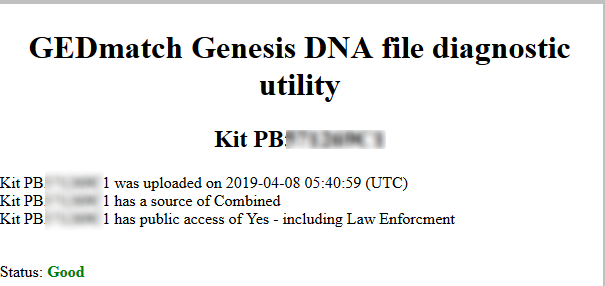I was heartbroken to learn that only about 200,000 of the more than a million kits at GEDmatch have opted in to helping law enforcement (LE). This means that most of the cases that were solved before the opt in requirement went into effect last year could not be solved today.

Dear reader, I am asking you to review the kits you have at GEDmatch and contact any cousins of yours who are not yet helping law enforcement. You might also ask relatives whose kits you do not manage if they are opted in. If you know of deceased relatives who would help if they could, send their obituary and kit number to support (there is now a form for that!) to opt them in.
Here is the email I am sending to all my hesitant cousins tonight and to many of my one-to-many matches whom I had been in touch with before. Feel free to use any of all of it in your own messages. [UPDATE: I have been accused of being too manipulative in the message below. Probably true, apologies to those I offended, but I do feel very strongly about this issue. Please reach out to your matches and relatives who have not opted in and use whatever words you prefer.]
Dear cousin —–,
I am writing to ask a favor of you. I am asking you to be a responsible citizen and bravely opt in to allowing law enforcement (LE) to compare the DNA of victims and criminals to your DNA kit at GEDmatch.com. LE cannot see your actual DNA, only the parts that match, if there are any, to the person they are looking for. Since I manage your kit, I only need you to respond yes to this message and I will take care of it for you.
[replace that sentance with this one when you do not manage their kit]
To opt in you need to log into GEDmatch, accept the new terms, and then click the police icon next to your kit number; here is a blog post explaining how https://blog.kittycooper.com/2019/05/please-opt-in-at-gedmatch/ (towards the bottom).
It broke my heart to learn that cases like finding the killer of Tanya Van Cuylenborg and Jay Cook, solving the identities of Jane and John Does (unknown deceased victims), or clearing a falsely imprisoned man like Christopher Tapp would probably not happen today because not enough people have opted in at GEDmatch (click any underlined words to read more about those cases).
The rules have changed so that informed consent is needed before law enforcement (LE) can compare the DNA kits of victims or criminals to yours to see if they are related to you. If they are, the tools of genetic genealogy can be used to triangulate the pedigrees to identify the family of the person of interest. This is only treated as a tip. The actual DNA of the suspect is then collected by LE from their discarded trash and compared to the crime scene DNA. [UPDATED:] Your DNA test usually remains anonymous in this process.
If you have any family members who are violent criminals, do you really want to protect them? This consent is only for violent crimes: perpetrators and victims. Please say yes, and thank you again so very much for testing your DNA which has enhanced my family research enormously.
Love cousin Kitty
UPDATE: I did not make it clear in the above post that you need to click the police icon in your list of DNA kits to opt in to let law enforcement compare their kits to yours.
So if your kit listing in the left column looks like this, click the word POLICE if you want to opt in:
![]()
One further point is that you can look up the kits of your relatives in the DNA File Diagnostic Utility to check if they have opted in. If they have not, no browbeating please, gentle persuasion or accept their decision…

